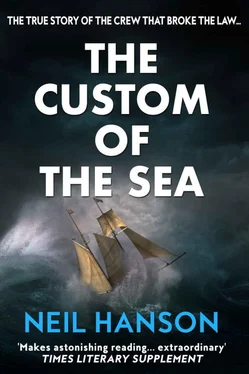If life for men in the Royal Navy was often grim — and the growth in traffic to the Black Sea resulting from the Crimean war had further increased the demands upon them — the ships in which they sailed were at least usually in a state of manageable repair. Merchant seamen had no such guarantee and the decrepit ‘coffin-ships’ of some corrupt shipowners were notorious.
The owners were protected by a powerful parliamentary lobby. When the Board of Trade attempted to explore the causes of the appalling level of losses of merchant shipping at sea, prominent shipowners set up such a clamour against ‘legislative interference… and restrictive practices which favour our foreign rivals,’ that, far from introducing further legislation, Lord Palmerston’s government was persuaded to repeal the existing laws governing deck-loading and the provision of watertight bulkheads.
Preventable losses multiplied as the Government withheld their scrutiny and insurance removed most of the financial risk to shipowners. Britain’s increasing control of the high seas led to falling insurance rates as the threat from pirates and corsairs was reduced. Greater competition in the insurance market also saw the traditional policy of paying out only 75 to 90 per cent of the insured value replaced by payment in full.
It had previously been in the interest of all owners to ensure that their ships were overhauled after each ocean voyage, and for safety reasons it was also the invariable practice to have a minimum of three inches of hull clear of the water for every foot of cargo space, measured from the keel to the main deck.
However, once full insurance was available, there was every incentive for the more avaricious ship-owners to overload their vessels, increasing the potential profit from each voyage by as much as 50 per cent. If the ship went down, the insurance at least covered the loss and often yielded a handsome profit, for some owners were insuring elderly vessels and their cargoes for considerably more than their true value.
It could be even more profitable for an owner to have his ship sink than deliver its cargo intact. One London owner insured a vessel that cost him £300 for £1,000. Another ship bought for £7,500 but insured for £10,000 sank with the loss of twenty lives. The owners collected a £2,500 profit, and the seamen’s wives and families were left destitute. There was no compensation for the crew… if they survived.
Even with ships and cargo worth tens of thousands of pounds, the liability of any individual underwriter was unlikely to exceed a couple of hundred pounds. None had the time or the available information to inquire into the provenance or condition of every ship he was asked to cover. It was cheaper and easier to pay the claim than attempt to mount an investigation into a loss on the high seas or on some distant coastline.
It was impossible to prove that coffin-ships were being deliberately wrecked or sent to sea in a condition that made foundering inevitable, but there was no doubt that many hundreds of seamen were sailing to their deaths each year in ships that were profoundly unseaworthy. If they complained or refused to sail, they were gaoled, for the law was emphatically on the side of the owners.
A full-rigged coaling ship, the Epaminodas , grounded twice while loading at the Tyne docks and shipped water at the rate of two and a half inches an hour. The ten-man crew refused to sail for Genoa in her and were promptly gaoled for three months by the South Shields magistrates.
Another ship loaded in London was condemned by a Lloyds surveyor as ‘utterly unfit to go to sea’ and her crew deserted en masse at Deal. They were gaoled and a fresh crew recruited. All were lost when the ship went down in the Atlantic.
The Lifeboat — the journal of the Royal National Lifeboat Institution — also reported the loss of the Utopia on a voyage from Liverpool to Bombay. It was so overloaded that it ran aground, sustaining severe damage while loading in Brunswick dock. The Mersey Dock and Harbour Board warned the owner of the safe loading limit and their surveyor painted the line on the hull, but it was loaded until the safe line was six inches below the water, then transferred to another dock where a further 120 tons of coke were put on board.
The captain protested to the owner, then resigned rather than sail in the ship. Lest the new captain had any thoughts about following his predecessor’s example, the shipping agent sent him a warning letter: ‘I must inform you that, after I have recommended you to the owner, if you do not go in the vessel, I will take care you never again get any employment in a ship out of Liverpool if I have any power to prevent you.’
The Utopia duly put to sea on 10 March 1867. Within hours there was three feet of water in the hold, and though the pumps were manned continually, the boat foundered within three days.
As the Lifeboat complained: ‘Any unprincipled ship-owner or his agent has the power to send and even to force a well-insured, unseaworthy ship to sea against the judgement and will of her master and crew, to their almost certain destruction.’
It was a national scandal and one man set out to challenge it. Samuel Plimsoll had been elected as MP for Derby on a pledge to force legislation that would protect merchant seamen, but his attempts to introduce a Merchant Shipping Survey Bill in 1871 were talked out by ship-owning MPs.
Instead a milk-and-water government Bill was passed. The Merchant Shipping Act compelled owners to mark draught scales and the name of the ship indelibly on the hull, and crews could also demand investigations into the seaworthiness of their vessels, but since they themselves had to meet the costs and were still liable to imprisonment if the investigation failed to satisfy the courts that the ship was dangerous, it was a near-worthless concession.
Disgusted, Plimsoll determined to arouse public opinion in his support. The means he chose, a book entitled Our Seamen , was published in December 1872. In it he denounced the unseaworthiness of a significant proportion of the merchant fleet, the callous and often barbaric treatment meted out to the crews and the greed and criminal negligence of corrupt ship-owners.
Apart from over-insurance, Plimsoll cited eight other causes of avoidable wrecks, including the undermanning that saw one steamer make the journey from Liverpool to the Far East with only eight hands, and a fully-rigged three-master go to sea with an eleven-man crew, barely half the number needed to handle the ship in safety.
Cargo was often so carelessly stacked that ships would roll over and founder when struck by a wave, or right themselves so violently that the ship’s frame and masts were sprung. Deck-loading made the vessels top-heavy, a situation that worsened during winter voyages when snow and ice could add further tons to the top-loading.
Even without deck cargo, overloading was potentially fatal to both sailing ships and steamers. Heavy-laden steamers often had insufficient engine power to make headway in even moderately rough sea conditions, and Plimsoll cited one ship sailing for the Baltic with its main deck two feet ten inches below the water level, and the spar deck only four feet two inches above it. The ship sank within eighteen miles of leaving port.
Faulty construction was also widespread, including the deliberate use of ‘devils’ — false bolts headed with copper but actually made of cheaper iron, which rusted away under the action of the acid bilge water — to fool ship surveyors. Even well-constructed ships were often left unrepaired and uninspected.
In refutation of claims that he was sensationalizing isolated or trivial incidents to further his own political career, Plimsoll quoted an august and unimpeachable source, the Lifeboat :
Читать дальше











